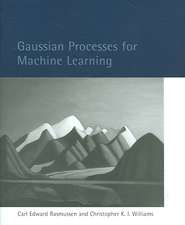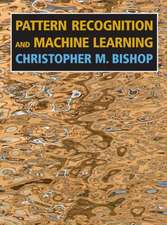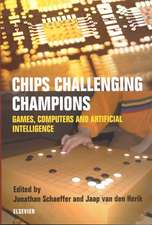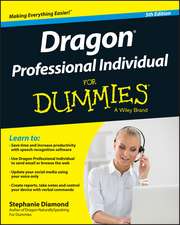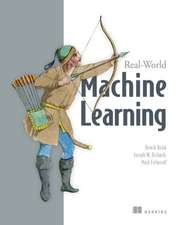Syntactic Pattern Recognition, Applications: Communication and Cybernetics, cartea 14
Editat de K.S. Fu Contribuţii de J.E. Albus, R. H. Anderson, J.M. Brayer, R. DeMori, H.-Y.F. Feng, S.L. Horowitz, B. Moayer, T. Pavlidis, W.W. Stallings, P.H. Swain, T. Vamosen Limba Engleză Paperback – 16 dec 2011
Preț: 642.03 lei
Preț vechi: 755.33 lei
-15% Nou
Puncte Express: 963
Preț estimativ în valută:
122.86€ • 131.37$ • 102.43£
122.86€ • 131.37$ • 102.43£
Carte tipărită la comandă
Livrare economică 18 aprilie-02 mai
Preluare comenzi: 021 569.72.76
Specificații
ISBN-13: 9783642664403
ISBN-10: 3642664407
Pagini: 288
Ilustrații: XII, 272 p.
Dimensiuni: 170 x 244 x 15 mm
Greutate: 0.46 kg
Ediția:Softcover reprint of the original 1st ed. 1977
Editura: Springer Berlin, Heidelberg
Colecția Springer
Seria Communication and Cybernetics
Locul publicării:Berlin, Heidelberg, Germany
ISBN-10: 3642664407
Pagini: 288
Ilustrații: XII, 272 p.
Dimensiuni: 170 x 244 x 15 mm
Greutate: 0.46 kg
Ediția:Softcover reprint of the original 1st ed. 1977
Editura: Springer Berlin, Heidelberg
Colecția Springer
Seria Communication and Cybernetics
Locul publicării:Berlin, Heidelberg, Germany
Public țintă
ResearchCuprins
1. Introduction to Syntactic Pattern Recognition..- 1.1 Syntactic (Structural) Approach to Pattern Recognition.- 1.2 Syntactic Pattern Recognition System.- 1.3 Selection of Pattern Primitives.- 1.4 Pattern Grammar.- 1.5 High-Dimensional Pattern Grammars.- 1.6 Syntax Analysis as Recognition Procedure.- 1.7 Concluding Remarks.- References.- 2. Peak Recognition in Waveforms..- 2.1 What is a Peak?.- 2.2 Practical Peak Recognition.- 2.3 Application to Electrocardiography.- 2.4 Concluding Remarks.- References.- 3. Electrocardiogram Interpretation Using a Stochastic Finite State Model..- 3.1 The Interpretation Problem.- 3.2 A Solution to the Interpretation Problem.- 3.3 A Simple Example.- 3.4 Application to Analog Signal Processing.- 3.5 An Example Application.- 3.6 The Solution to the Clock Signal Interpretation Problem.- 3.7 A Sample Clock Signal Search Tree.- 3.8 Conclusion.- References.- 4. Syntactic Recognition of Speech Patterns..- 4.1 Background.- 4.2 Preprocessing and Feature Extraction.- 4.3 Syntax-Controlled Segmentation of Continuous Speech.- 4.4 Syntactic Recognition of Syllables and Words.- 4.5 Linguistic Interpretation of Speech Patterns.- 4.6 Automatic Learning of Speech Patterns.- 4.7 Conclusions.- References.- 5. Chinese Character Recognition..- 5.1 Historical.- 5.2 The Morphology of Chinese Characters.- 5.3 Recognition of Chinese Characters.- References.- 6. Shape Discrimination..- 6.1 Basic Considerations.- 6.2 Description of Contours in Terms of Polygons.- 6.3 Description of the Shape of Polygons.- 6.4 Fundamentals of Decomposition.- 6.5 Further Decomposition and Shape Description.- 6.6 Decomposition of Polygons with Holes.- 6.7 Implementation of the Decomposition Algorithm.- 6.8 Discussion of the Methodology.- References.- 7. Two-Dimensional Mathematical Notation..- 7.1 Mathematics Notation.- 7.2 Coordinate Grammars.- 7.3 A Syntax-Directed Recognition Algorithm.- 7.4 Scope of Recognition Capability.- 7.5 Implementation and Efficiency.- 7.6 Summary.- Appendix 7.A.- Appendix 7.B.- References.- 8. Fingerprint Classification..- 8.1 Historical Background.- 8.2 Syntactic Approach.- 8.3 Tree Grammar Approach to Fingerprint Pattern Recognition.- 8.4 Summary.- References.- 9. Modeling of Earth Resources Satellite Data..- 9.1 The Satellite Data.- 9.2 The Model.- 9.3 Details of the Analysis.- 9.4 Inferring a Grammar for the Highways.- 9.5 Summary.- References.- 10. Industrial Objects and Machine Parts Recognition..- 10.1 A Short Review of Leading Ideas.- 10.2 Levels of Knowledge.- 10.3 Hardware.- 10.4 Software.- 10.5 Pattern Recognition.- 10.6 Conclusions.- References.

















